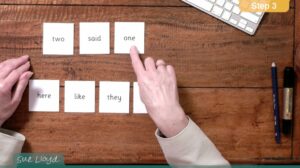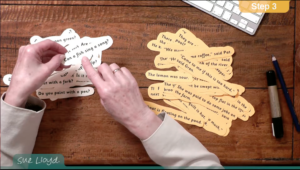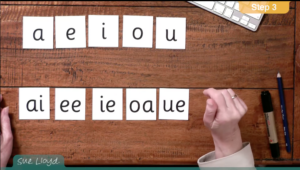Part 1 – Introduction of 12 new letter sounds
Part 1 – Introduction of 12 new letter sounds
The next 12 letter sounds are introduced. The children are taught that digraphs represent two sounds. They also learn to use the technique ‘if one way doesn’t work try the other’ when blending words with letter sounds that have more than one way of being pronounced.
Transcript
Print TranscriptPart 1: Introducing 12 new letter sounds
In Step 3, the children progress from reading and writing phrases, on to sentences, and then to reading books. The aim is for every child to:
- learn 12 new letter sounds, as well as revising the previous 30 letter sounds,
- write the new letter sounds from dictation, forming them correctly,
- blend and segment words that use the new and previous letter sounds,
- learn about capital letters, their sounds, and how to write them correctly,
- read and write 20 tricky words,
- read and write sentences that use the letter sounds and tricky wordsthat have been taught,
- and start reading the first level of decodable readers.The 12 new letter sounds are:
• Group 6: /y/ yes /x/ fox /ch/ chop /sh/ ship /th/ this /th/ that
• Group 7: /qu/ queen /ou/ out /oi/ oil /ue/ rescue /er/ her /ar/ arm
As you will notice, ‹th› is written in two sizes: /th/ and /th/. This is because,
like ‹oo› in Step 2, it has two sounds: the /th/ sound found in this, that and
with, and the /th/ sound found in thin, throat and cloth. The children have to
try both sounds when working out a new word with ‹th›; if /th/ does not work, then they try /th/.
There is another digraph in this group of letter sounds that has two sounds. This is the digraph ‹ue›, which has a /ue/ sound in words like rescue, statue and due but also makes an /oo/ sound in words like blue, glue and true. However, if the children try and say /ue/ for these words, it will sound a bit like /oo/, and so they easily jump from saying /bl-ue/ to /bl-oo/.
I used to get the children to remember this by saying /ue-oo/, as if calling to someone; then, if the /ue/ did not work, they would try /oo/. Once again, it is
worth pointing out that with some words the pronunciation varies. For example, the word due usually has a /ue/ sound in British English, but in American English it is more often pronounced with an /oo/: /d-oo/. There is no right or wrong. It is just the way language evolves in different parts of the world and in different areas of the same country. By trying /ue/ or /oo/, the children choose the one that is appropriate for their pronunciation.
In the English alphabetic code, ‹y› is an interesting letter because it can be a consonant or a vowel. In Step 3, it is a consonant and has a /y/ sound; it
usually comes at the beginning of words like yes, yell and yap. Later on, the children are taught that ‹y› can be a vowel (making the /ie/, /ee/ and /i/ sounds for example), but at this stage they simply learn that it has a /y/ sound. After /y/, the children are taught the other letter sounds, one after the other, usually at a rate of one a day [demonstration].
The next 12 letter sounds taught in Step 3 are provided. They can be used as flash cards to help the children remember the sounds linked to the letters or for word building.
The next 12 letter sounds taught in Step 3 are provided. They can be used as flash cards to help the children remember the sounds linked to the letters or for word building.
On these sheets the children are able to practise forming the next 12 letters correctly by following the dots.
On these sheets the children are able to practise forming the next 12 letters correctly by following the dots.
On these sheets the children are able to practice forming the next 12 letters correctly by following the dots.
On these sheets the children are able to practice forming the next 12 letters correctly by following the dots.
The words from the Word Bank can be printed on coloured card, cut up and used for blending practice. As each new letter sound is taught then more words become available for blending.
The words from the Word Bank can be printed on colored card, cut up and used for blending practice. As each new letter sound is taught then more words become available for blending.
The Step 3 phrases can be printed on card, cut up and used for reading practice. They are slightly more challenging than reading single words. It helps to prepare the children for reading sentences.
The Step 3 phrases can be printed on card, cut up and used for reading practice. They are slightly more challenging than reading single words. It helps to prepare the children for reading sentences.
The Step 3 phrases can be printed on card, cut up and used for reading practice. They are slightly more challenging than reading single words. It helps to prepare the children for reading sentences.
The Step 3 phrases can be printed on card, cut up and used for reading practice. They are slightly more challenging than reading single words. It helps to prepare the children for reading sentences.
The next 12 letter sounds taught in Step 3 are provided. They can be used as flash cards to help the children remember the sounds linked to the letters or for word building.
The next 12 letter sounds taught in Step 3 are provided. They can be used as flash cards to help the children remember the sounds linked to the letters or for word building.
On these sheets the children are able to practise forming the next 12 letters correctly by following the dots.
On these sheets the children are able to practise forming the next 12 letters correctly by following the dots.
On these sheets the children are able to practice forming the next 12 letters correctly by following the dots.
On these sheets the children are able to practice forming the next 12 letters correctly by following the dots.
The words from the Word Bank can be printed on coloured card, cut up and used for blending practice. As each new letter sound is taught then more words become available for blending.
The words from the Word Bank can be printed on colored card, cut up and used for blending practice. As each new letter sound is taught then more words become available for blending.
The Step 3 phrases can be printed on card, cut up and used for reading practice. They are slightly more challenging than reading single words. It helps to prepare the children for reading sentences.
The Step 3 phrases can be printed on card, cut up and used for reading practice. They are slightly more challenging than reading single words. It helps to prepare the children for reading sentences.
The Step 3 phrases can be printed on card, cut up and used for reading practice. They are slightly more challenging than reading single words. It helps to prepare the children for reading sentences.
The Step 3 phrases can be printed on card, cut up and used for reading practice. They are slightly more challenging than reading single words. It helps to prepare the children for reading sentences.
Tricky Words are frequently used words that either use alternative spellings that have not been taught yet or they are irregular. They can be blended but give the wrong pronunciation. The children have to remember the correct pronunciation and learn the unusual letter-sound correspondences.
Tricky Words are frequently used words that either use alternative spellings that have not been taught yet or they are irregular. They can be blended but give the wrong pronunciation. The children have to remember the correct pronunciation and learn the unusual letter-sound correspondences.
Tricky Words are frequently used words that either use alternative spellings that have not been taught yet or they are irregular. They can be blended but give the wrong pronunciation. The children have to remember the correct pronunciation and learn the unusual letter-sound correspondences.
Tricky Words are frequently used words that either use alternative spellings that have not been taught yet or they are irregular. They can be blended but give the wrong pronunciation. The children have to remember the correct pronunciation and learn the unusual letter-sound correspondences.
Tricky Words are frequently used words that either use alternative spellings that have not been taught yet or they are irregular. The children have to learn the awkward part for spelling. These sheets allow the children to practise writing the tricky words, using the Look, Cover, Write & Check method.
Tricky Words are frequently used words that either use alternative spellings that have not been taught yet or they are irregular. The children have to learn the awkward part for spelling. These sheets allow the children to practise writing the tricky words, using the Look, Cover, Write & Check method.
Tricky Words are frequently used words that either use alternative spellings that have not been taught yet or they are irregular. The children have to learn the awkward part for spelling. These sheets allow the children to practise writing the tricky words, using the Look, Cover, Write & Check method.
Tricky Words are frequently used words that either use alternative spellings that have not been taught yet or they are irregular. The children have to learn the awkward part for spelling. These sheets allow the children to practise writing the tricky words, using the Look, Cover, Write & Check method.
It is important to give children reading material that they can decode for themselves. Often they feel that books are too hard for them. These Question Sentences can help to fill the gap. They are sometimes amusing and provide another source of reading practice.
It is important to give children reading material that they can decode for themselves. Often they feel that books are too hard for them. These Question Sentences can help to fill the gap. They are sometimes amusing and provide another source of reading practice.
These sentences use the 42 letter sounds and tricky words 1-20. They provide more reading practice. Use in a similar way to the Question Sentences.
These sentences use the 42 letter sounds and tricky words 1-20. They provide more reading practice. Use in a similar way to the Question Sentences.
These words have been carefully selected. The children should be able to spell the dictated words correctly by listening for the sounds in the words and writing letters to represent the sounds. The words build up progressively until all 12 letter sounds are used.
These words have been carefully selected. The children should be able to spell the dictated words correctly by listening for the sounds in the words and writing letters to represent the sounds. The words build up progressively until all 12 letter sounds are used.
These words have been carefully selected. The children should be able to spell the dictated words correctly by listening for the sounds in the words and writing letters to represent the sounds. The words build up progressively until all 12 letter sounds are used.
These words have been carefully selected. The children should be able to spell the dictated words correctly by listening for the sounds in the words and writing letters to represent the sounds. The words build up progressively until all 12 letter sounds are used.
These sentences use the 42 letter sounds and tricky words 1 - 20. The children write the sentences from dictation either in the classroom or at home.
Guidance for forming the capital letters is shown by arrows and dots, which provides the children with the necessary practice and skills.
Guidance for forming the capital letters is shown by arrows and dots, which provides the children with the necessary practice and skills.


